Employee Engagement: Analysis and Business Outcomes Report
VerifiedAdded on 2022/12/14
|31
|5778
|420
Report
AI Summary
This comprehensive report on employee engagement provides a detailed analysis of its dimensions and components, differentiating it from organizational commitment, employee involvement, and job satisfaction. It identifies the principal drivers of an engaged workforce, such as meaningful work and employee voice, along with the associated business benefits, including increased productivity and customer satisfaction. The report explores organizational strategies for creating employee engagement through job design and discretionary behavior, emphasizing the importance of aligning engagement practices with corporate components. It evaluates diagnostic tools for measuring employee attitudes and engagement levels and provides examples of employee value propositions (EVP) and HR strategies aimed at raising engagement levels. The report concludes that employee engagement is a vital aspect for every organization since engaged employees lead to better productivity.
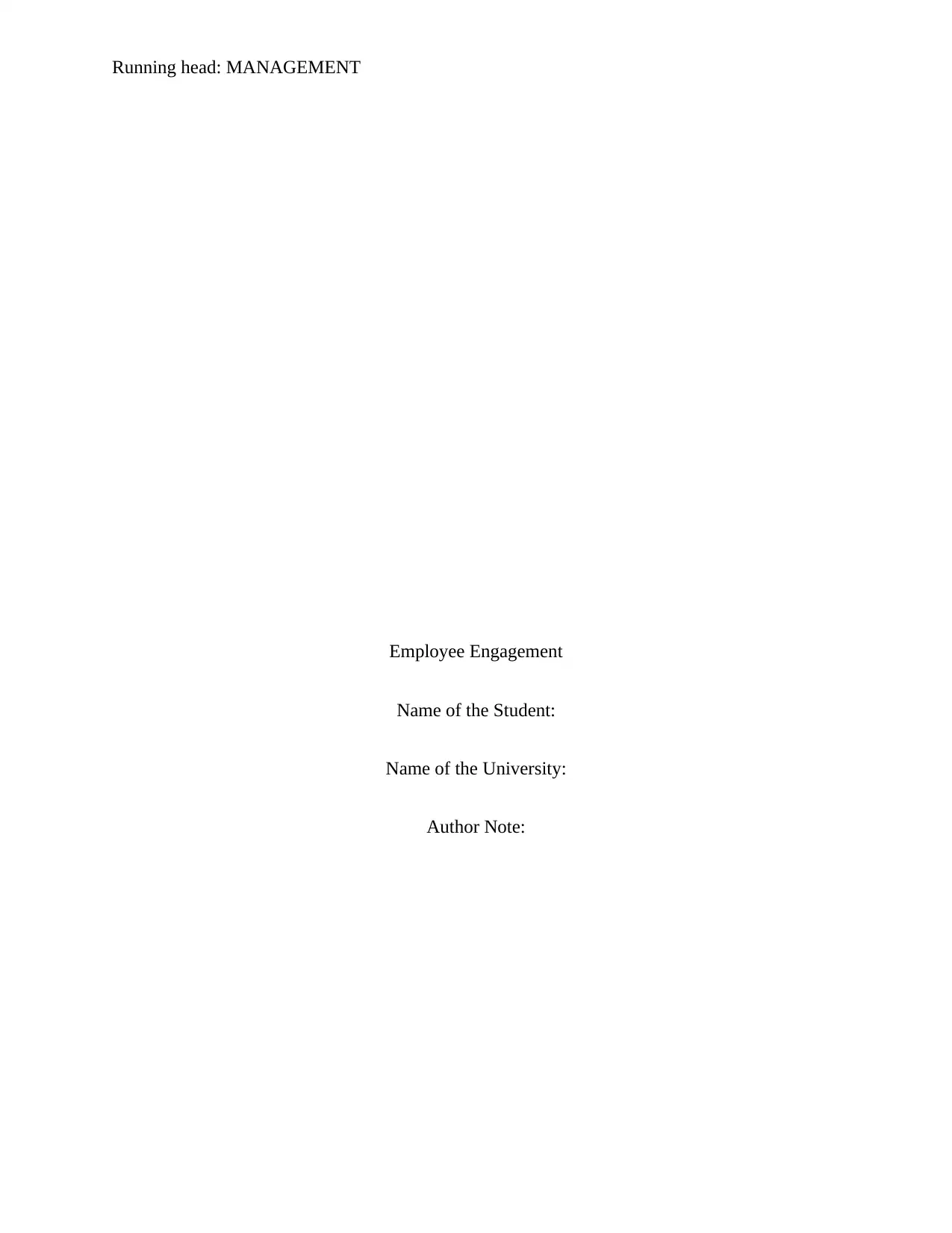
Running head: MANAGEMENT
Employee Engagement
Name of the Student:
Name of the University:
Author Note:
Employee Engagement
Name of the Student:
Name of the University:
Author Note:
Paraphrase This Document
Need a fresh take? Get an instant paraphrase of this document with our AI Paraphraser
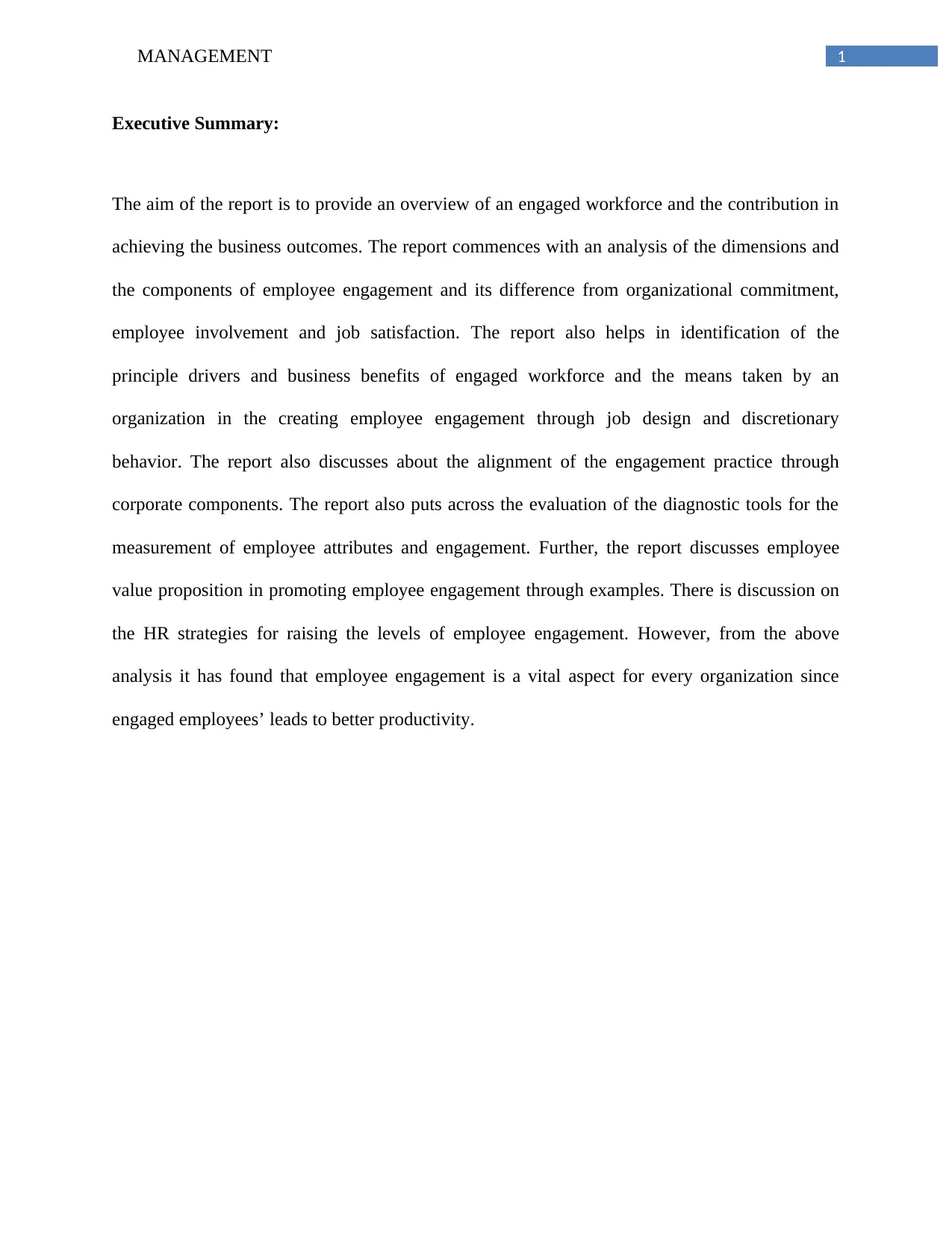
1MANAGEMENT
Executive Summary:
The aim of the report is to provide an overview of an engaged workforce and the contribution in
achieving the business outcomes. The report commences with an analysis of the dimensions and
the components of employee engagement and its difference from organizational commitment,
employee involvement and job satisfaction. The report also helps in identification of the
principle drivers and business benefits of engaged workforce and the means taken by an
organization in the creating employee engagement through job design and discretionary
behavior. The report also discusses about the alignment of the engagement practice through
corporate components. The report also puts across the evaluation of the diagnostic tools for the
measurement of employee attributes and engagement. Further, the report discusses employee
value proposition in promoting employee engagement through examples. There is discussion on
the HR strategies for raising the levels of employee engagement. However, from the above
analysis it has found that employee engagement is a vital aspect for every organization since
engaged employees’ leads to better productivity.
Executive Summary:
The aim of the report is to provide an overview of an engaged workforce and the contribution in
achieving the business outcomes. The report commences with an analysis of the dimensions and
the components of employee engagement and its difference from organizational commitment,
employee involvement and job satisfaction. The report also helps in identification of the
principle drivers and business benefits of engaged workforce and the means taken by an
organization in the creating employee engagement through job design and discretionary
behavior. The report also discusses about the alignment of the engagement practice through
corporate components. The report also puts across the evaluation of the diagnostic tools for the
measurement of employee attributes and engagement. Further, the report discusses employee
value proposition in promoting employee engagement through examples. There is discussion on
the HR strategies for raising the levels of employee engagement. However, from the above
analysis it has found that employee engagement is a vital aspect for every organization since
engaged employees’ leads to better productivity.

2MANAGEMENT
Table of Contents
Introduction:....................................................................................................................................3
Discussion:.......................................................................................................................................4
1. Analysis of Principal Dimensions and Components of Employee Engagement and its
Difference with Oranizational Commitment, Employer Involvement and Job Satisfaction..........4
2. Identification of the Principal Drivers and Business Benefit of an Engaged Workforce and
Steps Organization takes in Creating of Employee Engagement e.g. through job design,
discretionary behavior.....................................................................................................................8
3. Brief Explanation of the Need of Aligning the Engagement Practice with Corporate
Components...................................................................................................................................15
4. Evaluation of the Suitable Diagnostic Tools for Measuring Employee Attitude and Levels of
Employee Engagement..................................................................................................................16
5. Example of Employee Value Proposition (EVP) to Promote Levels of the Employee
Engagement...................................................................................................................................17
6. Examples of the Relevant HR Strategies for raising Levels of the Employee Engagement.....18
Conclusion:....................................................................................................................................20
References:....................................................................................................................................21
Appendices:...................................................................................................................................25
Appendix I: Summary of the Report.............................................................................................25
Table of Contents
Introduction:....................................................................................................................................3
Discussion:.......................................................................................................................................4
1. Analysis of Principal Dimensions and Components of Employee Engagement and its
Difference with Oranizational Commitment, Employer Involvement and Job Satisfaction..........4
2. Identification of the Principal Drivers and Business Benefit of an Engaged Workforce and
Steps Organization takes in Creating of Employee Engagement e.g. through job design,
discretionary behavior.....................................................................................................................8
3. Brief Explanation of the Need of Aligning the Engagement Practice with Corporate
Components...................................................................................................................................15
4. Evaluation of the Suitable Diagnostic Tools for Measuring Employee Attitude and Levels of
Employee Engagement..................................................................................................................16
5. Example of Employee Value Proposition (EVP) to Promote Levels of the Employee
Engagement...................................................................................................................................17
6. Examples of the Relevant HR Strategies for raising Levels of the Employee Engagement.....18
Conclusion:....................................................................................................................................20
References:....................................................................................................................................21
Appendices:...................................................................................................................................25
Appendix I: Summary of the Report.............................................................................................25
⊘ This is a preview!⊘
Do you want full access?
Subscribe today to unlock all pages.

Trusted by 1+ million students worldwide
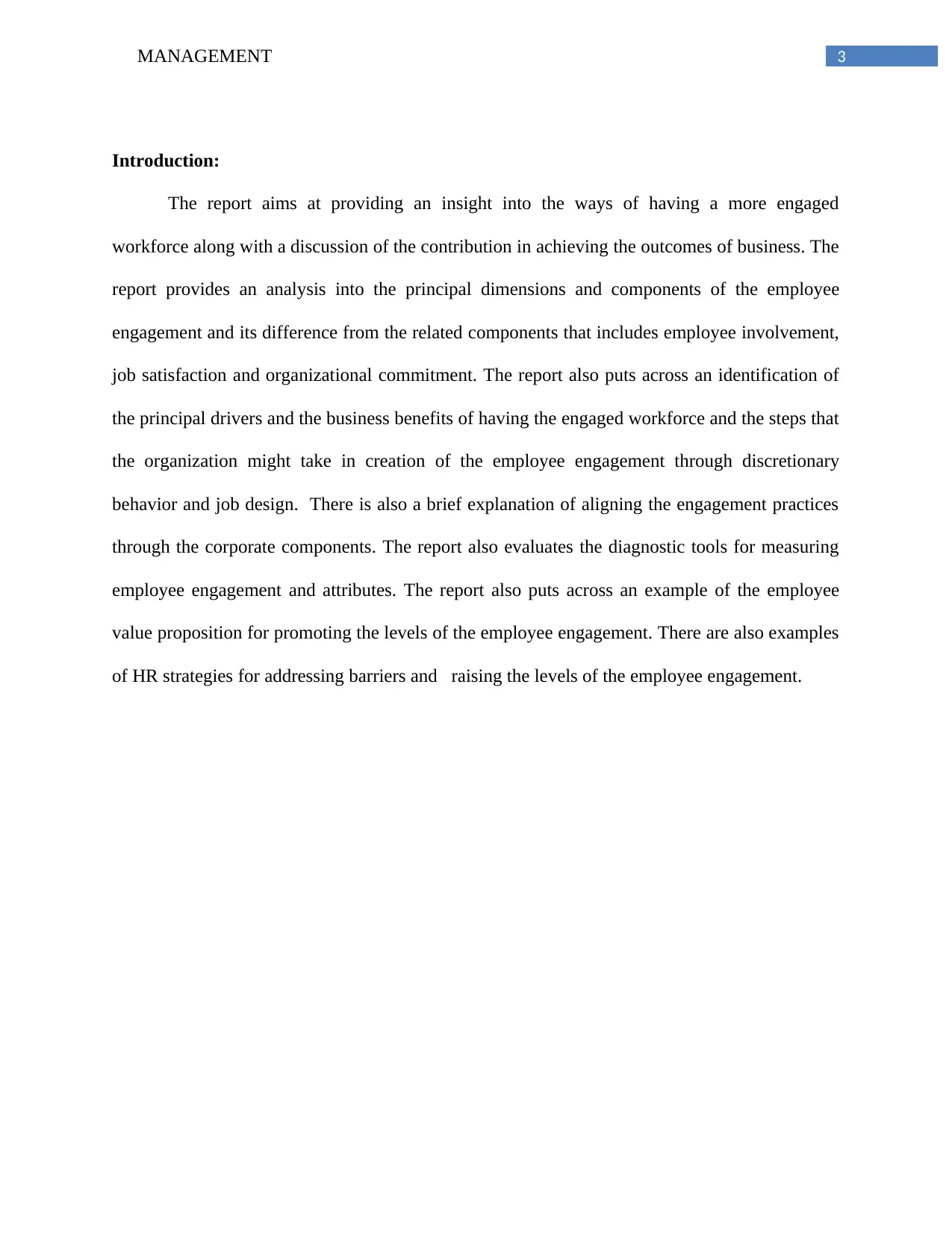
3MANAGEMENT
Introduction:
The report aims at providing an insight into the ways of having a more engaged
workforce along with a discussion of the contribution in achieving the outcomes of business. The
report provides an analysis into the principal dimensions and components of the employee
engagement and its difference from the related components that includes employee involvement,
job satisfaction and organizational commitment. The report also puts across an identification of
the principal drivers and the business benefits of having the engaged workforce and the steps that
the organization might take in creation of the employee engagement through discretionary
behavior and job design. There is also a brief explanation of aligning the engagement practices
through the corporate components. The report also evaluates the diagnostic tools for measuring
employee engagement and attributes. The report also puts across an example of the employee
value proposition for promoting the levels of the employee engagement. There are also examples
of HR strategies for addressing barriers and raising the levels of the employee engagement.
Introduction:
The report aims at providing an insight into the ways of having a more engaged
workforce along with a discussion of the contribution in achieving the outcomes of business. The
report provides an analysis into the principal dimensions and components of the employee
engagement and its difference from the related components that includes employee involvement,
job satisfaction and organizational commitment. The report also puts across an identification of
the principal drivers and the business benefits of having the engaged workforce and the steps that
the organization might take in creation of the employee engagement through discretionary
behavior and job design. There is also a brief explanation of aligning the engagement practices
through the corporate components. The report also evaluates the diagnostic tools for measuring
employee engagement and attributes. The report also puts across an example of the employee
value proposition for promoting the levels of the employee engagement. There are also examples
of HR strategies for addressing barriers and raising the levels of the employee engagement.
Paraphrase This Document
Need a fresh take? Get an instant paraphrase of this document with our AI Paraphraser

4MANAGEMENT
Discussion:
1. Analysis of Principal Dimensions and Components of Employee Engagement and its
Difference with Oranizational Commitment, Employer Involvement and Job Satisfaction
Employee engagement refers to the connection that the employee expressess towards
his or her organization that helps in influencing their behavior and the extent of the work related
activities (Anitha 2014). In other words, empployee engagement can be defined as, “Employee
engagement is a workplace approach designed to ensure that employees are committed to their
organisation’s goals and values, motivated to contribute to organisational success, and are able at
the same time to enhance their own sense of well-being”. There exists two perspectives of
employee engagement. The first perpective according to Rothmann and Welsh (2013) mention
that “Engaged workers perform better and give extra discretionary effort”. The other perspective
according to CIPD (2009) puts across that “Employers want engaged employees because they
deliver improved business performance”.
Bakker & Demerouti (2014) tried to explain the concept of employee engagement with
the help of job demands-resources model also known as the JD-R model. This represented an
occupational stress model that suggested strain acts as the response between the demands of the
individual and the resources available for meeting the demands.
Discussion:
1. Analysis of Principal Dimensions and Components of Employee Engagement and its
Difference with Oranizational Commitment, Employer Involvement and Job Satisfaction
Employee engagement refers to the connection that the employee expressess towards
his or her organization that helps in influencing their behavior and the extent of the work related
activities (Anitha 2014). In other words, empployee engagement can be defined as, “Employee
engagement is a workplace approach designed to ensure that employees are committed to their
organisation’s goals and values, motivated to contribute to organisational success, and are able at
the same time to enhance their own sense of well-being”. There exists two perspectives of
employee engagement. The first perpective according to Rothmann and Welsh (2013) mention
that “Engaged workers perform better and give extra discretionary effort”. The other perspective
according to CIPD (2009) puts across that “Employers want engaged employees because they
deliver improved business performance”.
Bakker & Demerouti (2014) tried to explain the concept of employee engagement with
the help of job demands-resources model also known as the JD-R model. This represented an
occupational stress model that suggested strain acts as the response between the demands of the
individual and the resources available for meeting the demands.

5MANAGEMENT
Figure 1: JD-R Model
Source: (Bakker, Demerouti and Sanz-Vergel 2014)
The principal dimensions of employee engagement include (Warr and Inceoglu 2012):
Intellectual: This dimension portrays the thought about the ways of improvement
Affective: This dimension expresses positive feelings about the job
Social: This dimension is primarily focused on the improvements and the active
discussions
The components of the employee engagement includes growth opportunity, skills to be
successful and passion for the job. Opportunities for the growth refers to the expansion of skill,
knowledge and abilities of the employees and apply them in newer situations. Skills on the other
Figure 1: JD-R Model
Source: (Bakker, Demerouti and Sanz-Vergel 2014)
The principal dimensions of employee engagement include (Warr and Inceoglu 2012):
Intellectual: This dimension portrays the thought about the ways of improvement
Affective: This dimension expresses positive feelings about the job
Social: This dimension is primarily focused on the improvements and the active
discussions
The components of the employee engagement includes growth opportunity, skills to be
successful and passion for the job. Opportunities for the growth refers to the expansion of skill,
knowledge and abilities of the employees and apply them in newer situations. Skills on the other
⊘ This is a preview!⊘
Do you want full access?
Subscribe today to unlock all pages.

Trusted by 1+ million students worldwide
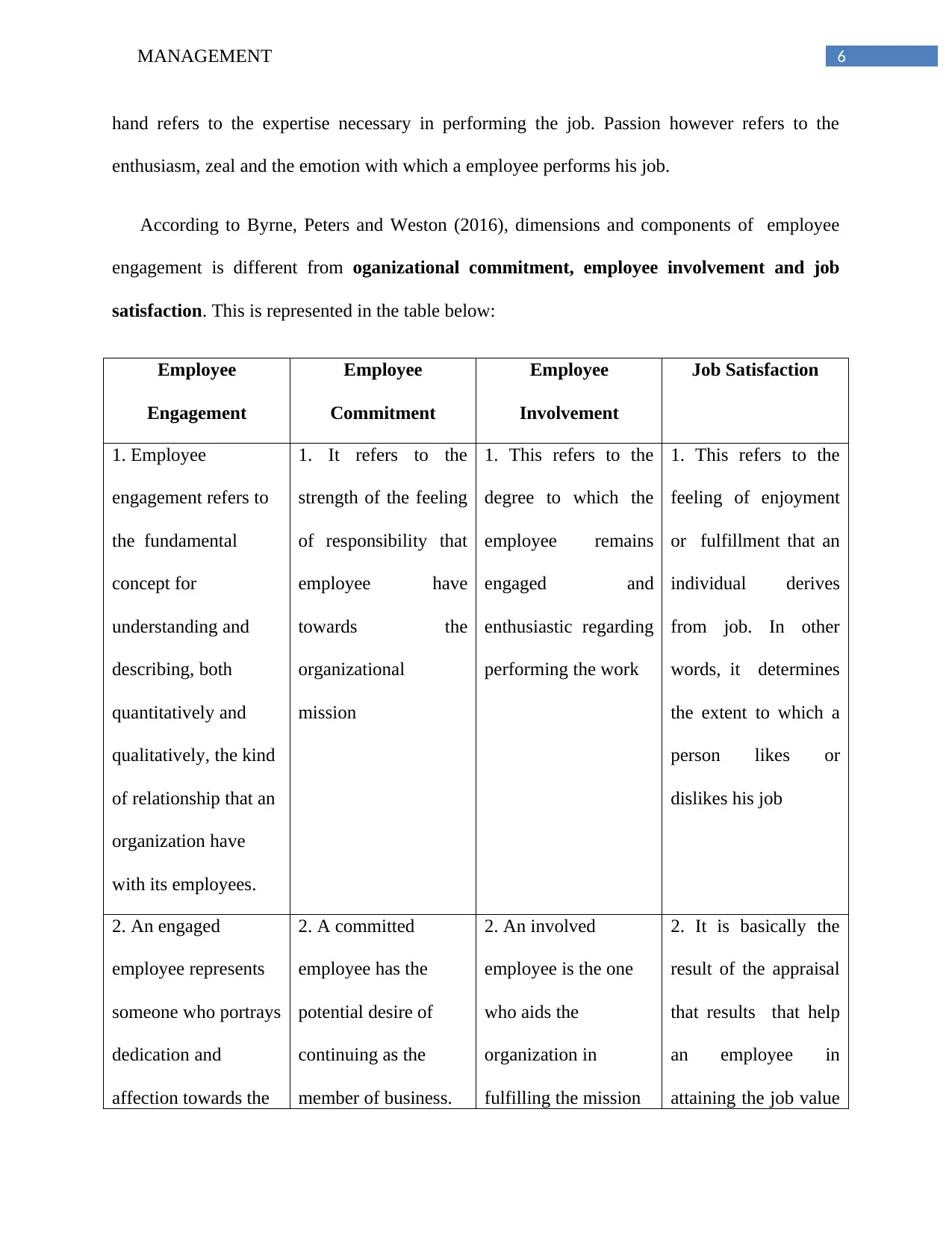
6MANAGEMENT
hand refers to the expertise necessary in performing the job. Passion however refers to the
enthusiasm, zeal and the emotion with which a employee performs his job.
According to Byrne, Peters and Weston (2016), dimensions and components of employee
engagement is different from oganizational commitment, employee involvement and job
satisfaction. This is represented in the table below:
Employee
Engagement
Employee
Commitment
Employee
Involvement
Job Satisfaction
1. Employee
engagement refers to
the fundamental
concept for
understanding and
describing, both
quantitatively and
qualitatively, the kind
of relationship that an
organization have
with its employees.
1. It refers to the
strength of the feeling
of responsibility that
employee have
towards the
organizational
mission
1. This refers to the
degree to which the
employee remains
engaged and
enthusiastic regarding
performing the work
1. This refers to the
feeling of enjoyment
or fulfillment that an
individual derives
from job. In other
words, it determines
the extent to which a
person likes or
dislikes his job
2. An engaged
employee represents
someone who portrays
dedication and
affection towards the
2. A committed
employee has the
potential desire of
continuing as the
member of business.
2. An involved
employee is the one
who aids the
organization in
fulfilling the mission
2. It is basically the
result of the appraisal
that results that help
an employee in
attaining the job value
hand refers to the expertise necessary in performing the job. Passion however refers to the
enthusiasm, zeal and the emotion with which a employee performs his job.
According to Byrne, Peters and Weston (2016), dimensions and components of employee
engagement is different from oganizational commitment, employee involvement and job
satisfaction. This is represented in the table below:
Employee
Engagement
Employee
Commitment
Employee
Involvement
Job Satisfaction
1. Employee
engagement refers to
the fundamental
concept for
understanding and
describing, both
quantitatively and
qualitatively, the kind
of relationship that an
organization have
with its employees.
1. It refers to the
strength of the feeling
of responsibility that
employee have
towards the
organizational
mission
1. This refers to the
degree to which the
employee remains
engaged and
enthusiastic regarding
performing the work
1. This refers to the
feeling of enjoyment
or fulfillment that an
individual derives
from job. In other
words, it determines
the extent to which a
person likes or
dislikes his job
2. An engaged
employee represents
someone who portrays
dedication and
affection towards the
2. A committed
employee has the
potential desire of
continuing as the
member of business.
2. An involved
employee is the one
who aids the
organization in
fulfilling the mission
2. It is basically the
result of the appraisal
that results that help
an employee in
attaining the job value
Paraphrase This Document
Need a fresh take? Get an instant paraphrase of this document with our AI Paraphraser

7MANAGEMENT
job that he/ she
performs without any
specific interest
except act as the
opportunity provider
for carrying out the
job.
He/she has a stronger
acceptance and belief
of the goals and
values of the business.
He/she also have the
willingness in going
the additional mile on
the behalf of
organization.
and meeting the
objectives through
application of their
expertise, ideas and
efforts towards
making decisions and
solving the problems
or meeting the basic
needs.
According to Cole et al. (2012), it is to be noted that productivity and improved
performance remains at the heart of the engagement which cannot be achieved through a
mechanistic approach that tries in extracting the discretionary effort through manipulating the
employee emotions and commitment. Employee can easily see through the attempts which lead
to the employee disillusionment and cynicism. In contrast to this, it can be said that the engaged
employees willingly and freely put forward discretionary effort as an integral part of the day to
day activity at work.
Swarnalatha and Prasanna (2013) stated that engagement represented a two way process
and the organizations should work towards engaging the employees who in return have the
choice regarding level of engagement for offering to the employees. An engaged employee
experiences blend of the organizational commitment, job involvement and satisfaction along
with the feelings of the empowerment. It refers to the concept that acts greater compared to
addition of the parts.
job that he/ she
performs without any
specific interest
except act as the
opportunity provider
for carrying out the
job.
He/she has a stronger
acceptance and belief
of the goals and
values of the business.
He/she also have the
willingness in going
the additional mile on
the behalf of
organization.
and meeting the
objectives through
application of their
expertise, ideas and
efforts towards
making decisions and
solving the problems
or meeting the basic
needs.
According to Cole et al. (2012), it is to be noted that productivity and improved
performance remains at the heart of the engagement which cannot be achieved through a
mechanistic approach that tries in extracting the discretionary effort through manipulating the
employee emotions and commitment. Employee can easily see through the attempts which lead
to the employee disillusionment and cynicism. In contrast to this, it can be said that the engaged
employees willingly and freely put forward discretionary effort as an integral part of the day to
day activity at work.
Swarnalatha and Prasanna (2013) stated that engagement represented a two way process
and the organizations should work towards engaging the employees who in return have the
choice regarding level of engagement for offering to the employees. An engaged employee
experiences blend of the organizational commitment, job involvement and satisfaction along
with the feelings of the empowerment. It refers to the concept that acts greater compared to
addition of the parts.

8MANAGEMENT
In spite of the debate regarding precise meaning of the employee engagement there are
three things that needs to be known. This includes that employee engagement is measurable;
remains correlated with performance and varies from poor to the great. The vital aspect in this is
that employers play a huge role in impacting the level of engagement of the people (Nienaber
and Martins 2014) This makes it as one the most important tools in determining the success of
the business.
2. Identification of the Principal Drivers and Business Benefit of an Engaged Workforce
and Steps Organization takes in Creating of Employee Engagement e.g. through job
design, discretionary behavior
The principal drivers of an engaged workforce includes:
Meaningfulness of the work: This is the most important driver where the senior
leadership has vision & communication and the line manager have a positive perception.
According to Deloitte report, a survey conducted on 560 employees identified
meaningfulness of the work as the third important driver of employee engagement
according to 76 percent of the respondents (Mone and London 2018). Here it is
important to note that being engaged at work seems next to impossible if the work done
by the employer does not seem to engage. Such situations results in creation of
inadequacy, frustration and unhappiness.
Opinions on Management: According to Deloitte research, it has been found that over
six in every ten employees who planned in staying with the current employees reported
higher trust level in the corporate leadership while only a mere 27 percent of the
employees who plans for leaving expresses similar trust(Nair and Vohra 2015). Again,
In spite of the debate regarding precise meaning of the employee engagement there are
three things that needs to be known. This includes that employee engagement is measurable;
remains correlated with performance and varies from poor to the great. The vital aspect in this is
that employers play a huge role in impacting the level of engagement of the people (Nienaber
and Martins 2014) This makes it as one the most important tools in determining the success of
the business.
2. Identification of the Principal Drivers and Business Benefit of an Engaged Workforce
and Steps Organization takes in Creating of Employee Engagement e.g. through job
design, discretionary behavior
The principal drivers of an engaged workforce includes:
Meaningfulness of the work: This is the most important driver where the senior
leadership has vision & communication and the line manager have a positive perception.
According to Deloitte report, a survey conducted on 560 employees identified
meaningfulness of the work as the third important driver of employee engagement
according to 76 percent of the respondents (Mone and London 2018). Here it is
important to note that being engaged at work seems next to impossible if the work done
by the employer does not seem to engage. Such situations results in creation of
inadequacy, frustration and unhappiness.
Opinions on Management: According to Deloitte research, it has been found that over
six in every ten employees who planned in staying with the current employees reported
higher trust level in the corporate leadership while only a mere 27 percent of the
employees who plans for leaving expresses similar trust(Nair and Vohra 2015). Again,
⊘ This is a preview!⊘
Do you want full access?
Subscribe today to unlock all pages.

Trusted by 1+ million students worldwide
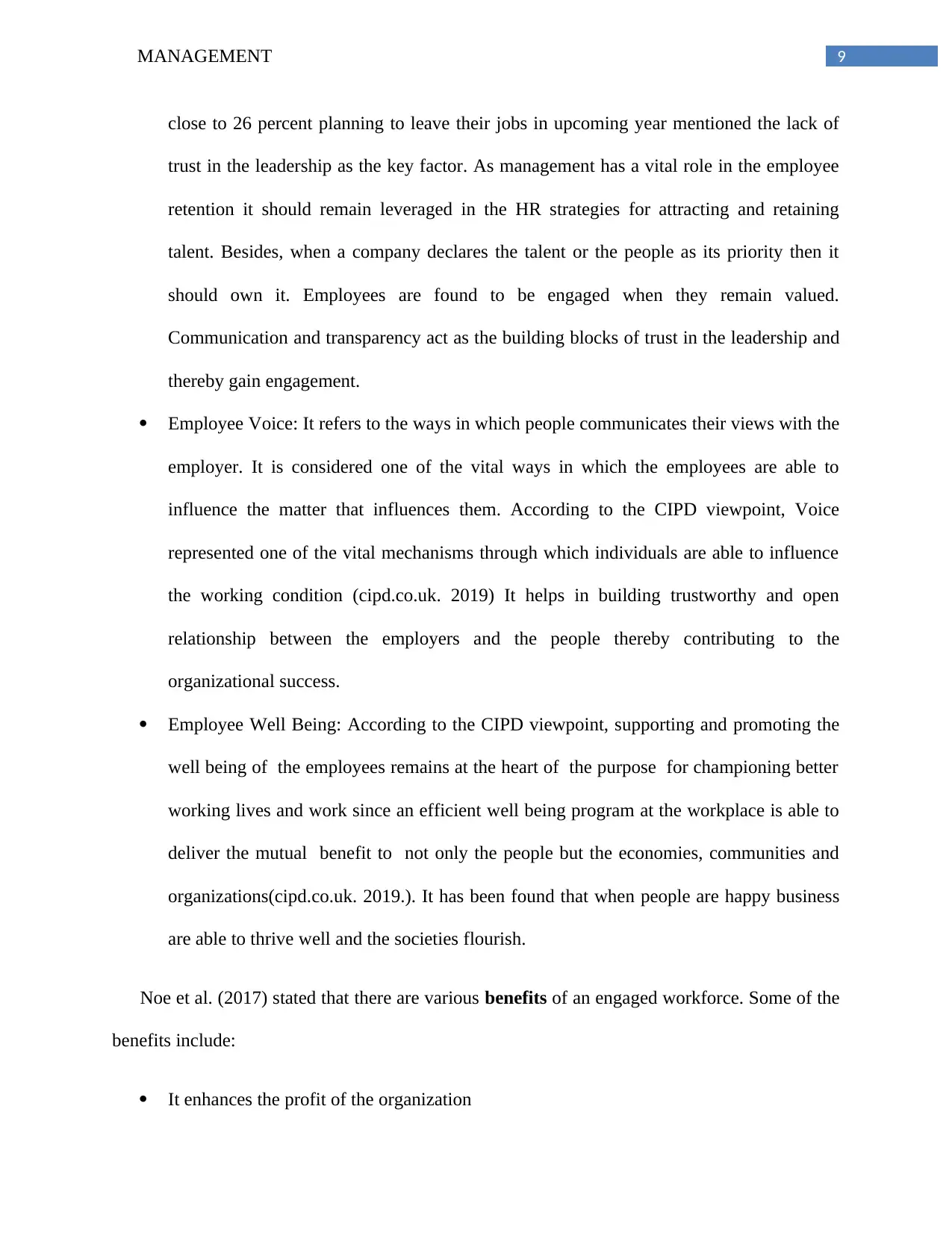
9MANAGEMENT
close to 26 percent planning to leave their jobs in upcoming year mentioned the lack of
trust in the leadership as the key factor. As management has a vital role in the employee
retention it should remain leveraged in the HR strategies for attracting and retaining
talent. Besides, when a company declares the talent or the people as its priority then it
should own it. Employees are found to be engaged when they remain valued.
Communication and transparency act as the building blocks of trust in the leadership and
thereby gain engagement.
Employee Voice: It refers to the ways in which people communicates their views with the
employer. It is considered one of the vital ways in which the employees are able to
influence the matter that influences them. According to the CIPD viewpoint, Voice
represented one of the vital mechanisms through which individuals are able to influence
the working condition (cipd.co.uk. 2019) It helps in building trustworthy and open
relationship between the employers and the people thereby contributing to the
organizational success.
Employee Well Being: According to the CIPD viewpoint, supporting and promoting the
well being of the employees remains at the heart of the purpose for championing better
working lives and work since an efficient well being program at the workplace is able to
deliver the mutual benefit to not only the people but the economies, communities and
organizations(cipd.co.uk. 2019.). It has been found that when people are happy business
are able to thrive well and the societies flourish.
Noe et al. (2017) stated that there are various benefits of an engaged workforce. Some of the
benefits include:
It enhances the profit of the organization
close to 26 percent planning to leave their jobs in upcoming year mentioned the lack of
trust in the leadership as the key factor. As management has a vital role in the employee
retention it should remain leveraged in the HR strategies for attracting and retaining
talent. Besides, when a company declares the talent or the people as its priority then it
should own it. Employees are found to be engaged when they remain valued.
Communication and transparency act as the building blocks of trust in the leadership and
thereby gain engagement.
Employee Voice: It refers to the ways in which people communicates their views with the
employer. It is considered one of the vital ways in which the employees are able to
influence the matter that influences them. According to the CIPD viewpoint, Voice
represented one of the vital mechanisms through which individuals are able to influence
the working condition (cipd.co.uk. 2019) It helps in building trustworthy and open
relationship between the employers and the people thereby contributing to the
organizational success.
Employee Well Being: According to the CIPD viewpoint, supporting and promoting the
well being of the employees remains at the heart of the purpose for championing better
working lives and work since an efficient well being program at the workplace is able to
deliver the mutual benefit to not only the people but the economies, communities and
organizations(cipd.co.uk. 2019.). It has been found that when people are happy business
are able to thrive well and the societies flourish.
Noe et al. (2017) stated that there are various benefits of an engaged workforce. Some of the
benefits include:
It enhances the profit of the organization
Paraphrase This Document
Need a fresh take? Get an instant paraphrase of this document with our AI Paraphraser
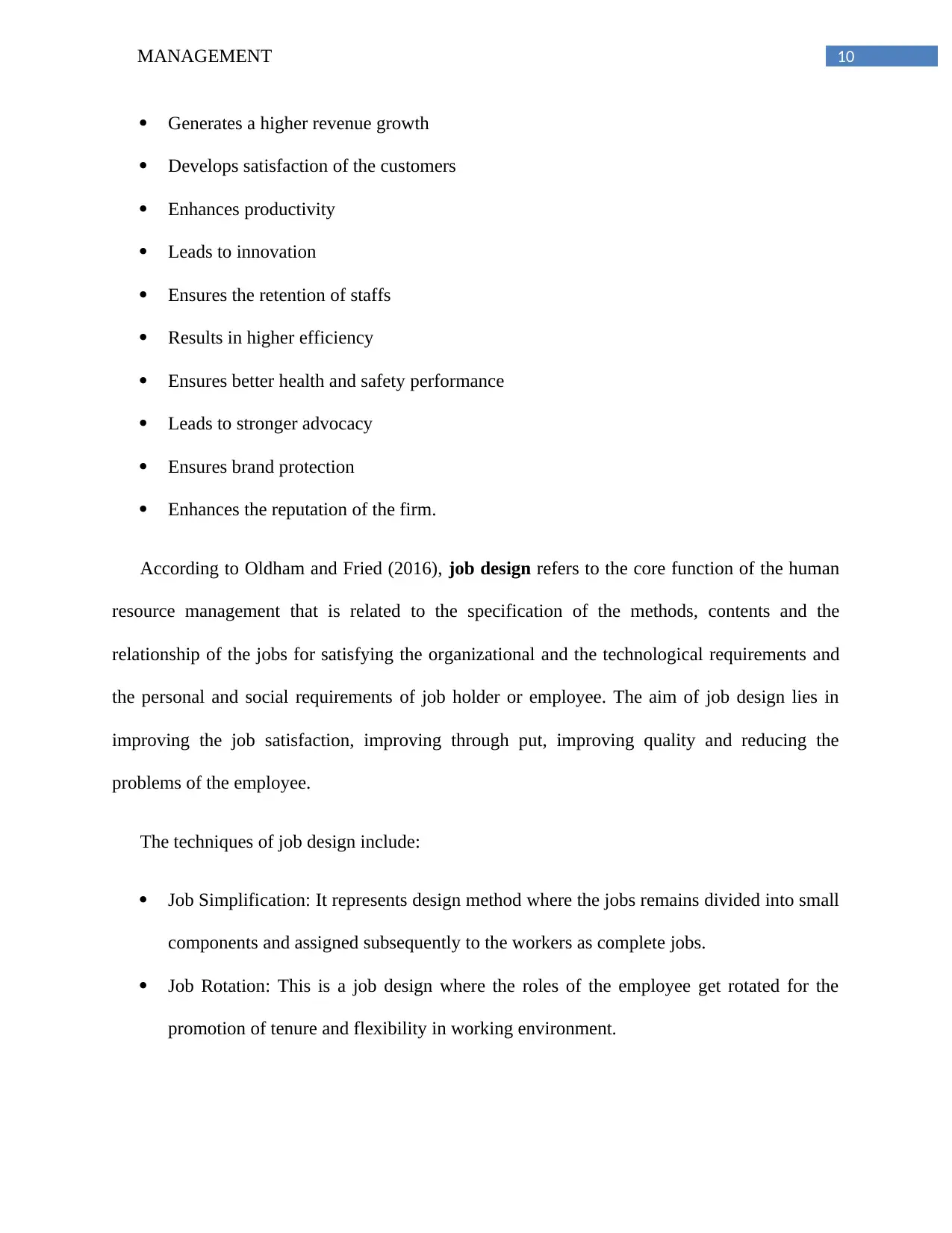
10MANAGEMENT
Generates a higher revenue growth
Develops satisfaction of the customers
Enhances productivity
Leads to innovation
Ensures the retention of staffs
Results in higher efficiency
Ensures better health and safety performance
Leads to stronger advocacy
Ensures brand protection
Enhances the reputation of the firm.
According to Oldham and Fried (2016), job design refers to the core function of the human
resource management that is related to the specification of the methods, contents and the
relationship of the jobs for satisfying the organizational and the technological requirements and
the personal and social requirements of job holder or employee. The aim of job design lies in
improving the job satisfaction, improving through put, improving quality and reducing the
problems of the employee.
The techniques of job design include:
Job Simplification: It represents design method where the jobs remains divided into small
components and assigned subsequently to the workers as complete jobs.
Job Rotation: This is a job design where the roles of the employee get rotated for the
promotion of tenure and flexibility in working environment.
Generates a higher revenue growth
Develops satisfaction of the customers
Enhances productivity
Leads to innovation
Ensures the retention of staffs
Results in higher efficiency
Ensures better health and safety performance
Leads to stronger advocacy
Ensures brand protection
Enhances the reputation of the firm.
According to Oldham and Fried (2016), job design refers to the core function of the human
resource management that is related to the specification of the methods, contents and the
relationship of the jobs for satisfying the organizational and the technological requirements and
the personal and social requirements of job holder or employee. The aim of job design lies in
improving the job satisfaction, improving through put, improving quality and reducing the
problems of the employee.
The techniques of job design include:
Job Simplification: It represents design method where the jobs remains divided into small
components and assigned subsequently to the workers as complete jobs.
Job Rotation: This is a job design where the roles of the employee get rotated for the
promotion of tenure and flexibility in working environment.
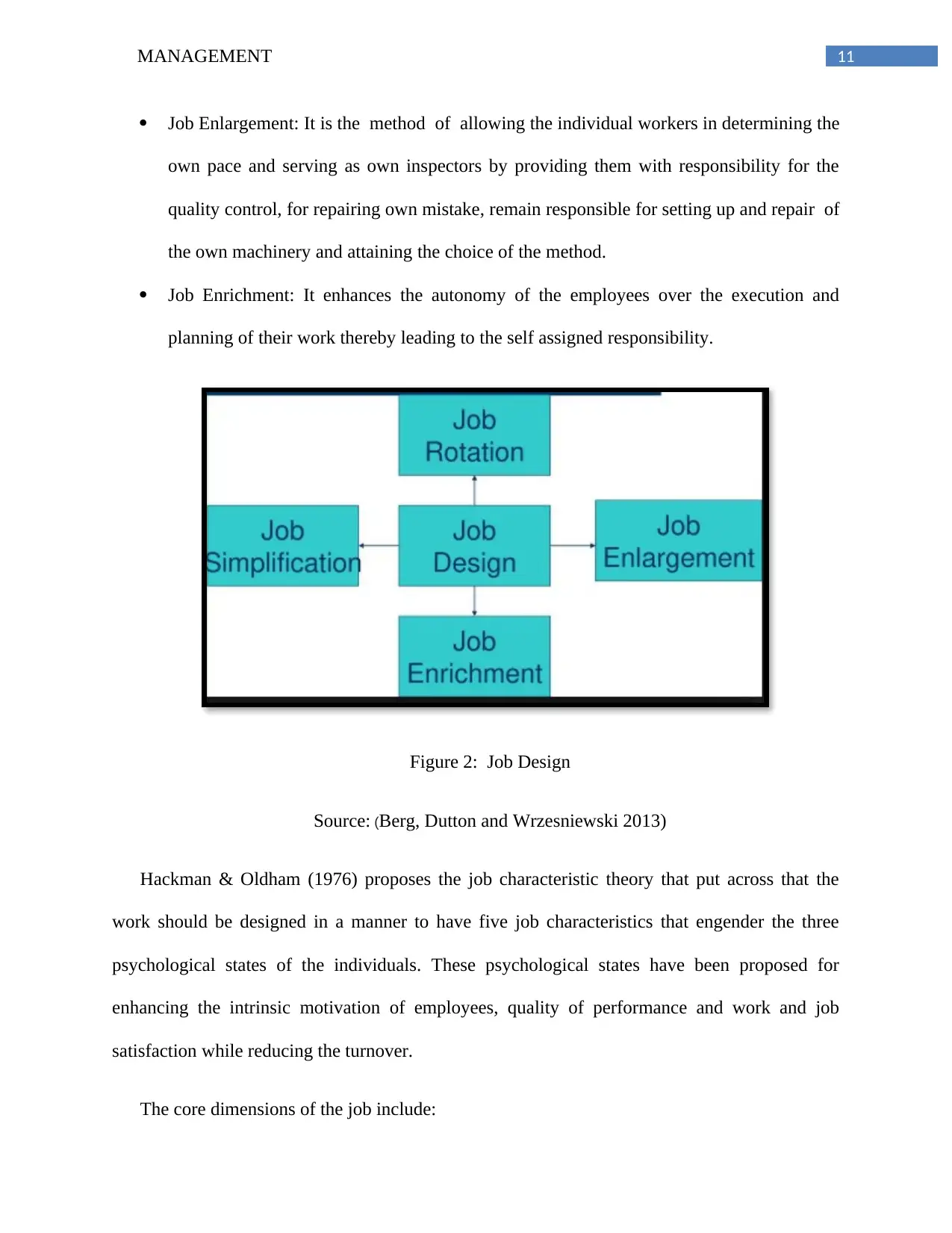
11MANAGEMENT
Job Enlargement: It is the method of allowing the individual workers in determining the
own pace and serving as own inspectors by providing them with responsibility for the
quality control, for repairing own mistake, remain responsible for setting up and repair of
the own machinery and attaining the choice of the method.
Job Enrichment: It enhances the autonomy of the employees over the execution and
planning of their work thereby leading to the self assigned responsibility.
Figure 2: Job Design
Source: (Berg, Dutton and Wrzesniewski 2013)
Hackman & Oldham (1976) proposes the job characteristic theory that put across that the
work should be designed in a manner to have five job characteristics that engender the three
psychological states of the individuals. These psychological states have been proposed for
enhancing the intrinsic motivation of employees, quality of performance and work and job
satisfaction while reducing the turnover.
The core dimensions of the job include:
Job Enlargement: It is the method of allowing the individual workers in determining the
own pace and serving as own inspectors by providing them with responsibility for the
quality control, for repairing own mistake, remain responsible for setting up and repair of
the own machinery and attaining the choice of the method.
Job Enrichment: It enhances the autonomy of the employees over the execution and
planning of their work thereby leading to the self assigned responsibility.
Figure 2: Job Design
Source: (Berg, Dutton and Wrzesniewski 2013)
Hackman & Oldham (1976) proposes the job characteristic theory that put across that the
work should be designed in a manner to have five job characteristics that engender the three
psychological states of the individuals. These psychological states have been proposed for
enhancing the intrinsic motivation of employees, quality of performance and work and job
satisfaction while reducing the turnover.
The core dimensions of the job include:
⊘ This is a preview!⊘
Do you want full access?
Subscribe today to unlock all pages.

Trusted by 1+ million students worldwide
1 out of 31
Related Documents
Your All-in-One AI-Powered Toolkit for Academic Success.
+13062052269
info@desklib.com
Available 24*7 on WhatsApp / Email
![[object Object]](/_next/static/media/star-bottom.7253800d.svg)
Unlock your academic potential
Copyright © 2020–2025 A2Z Services. All Rights Reserved. Developed and managed by ZUCOL.





